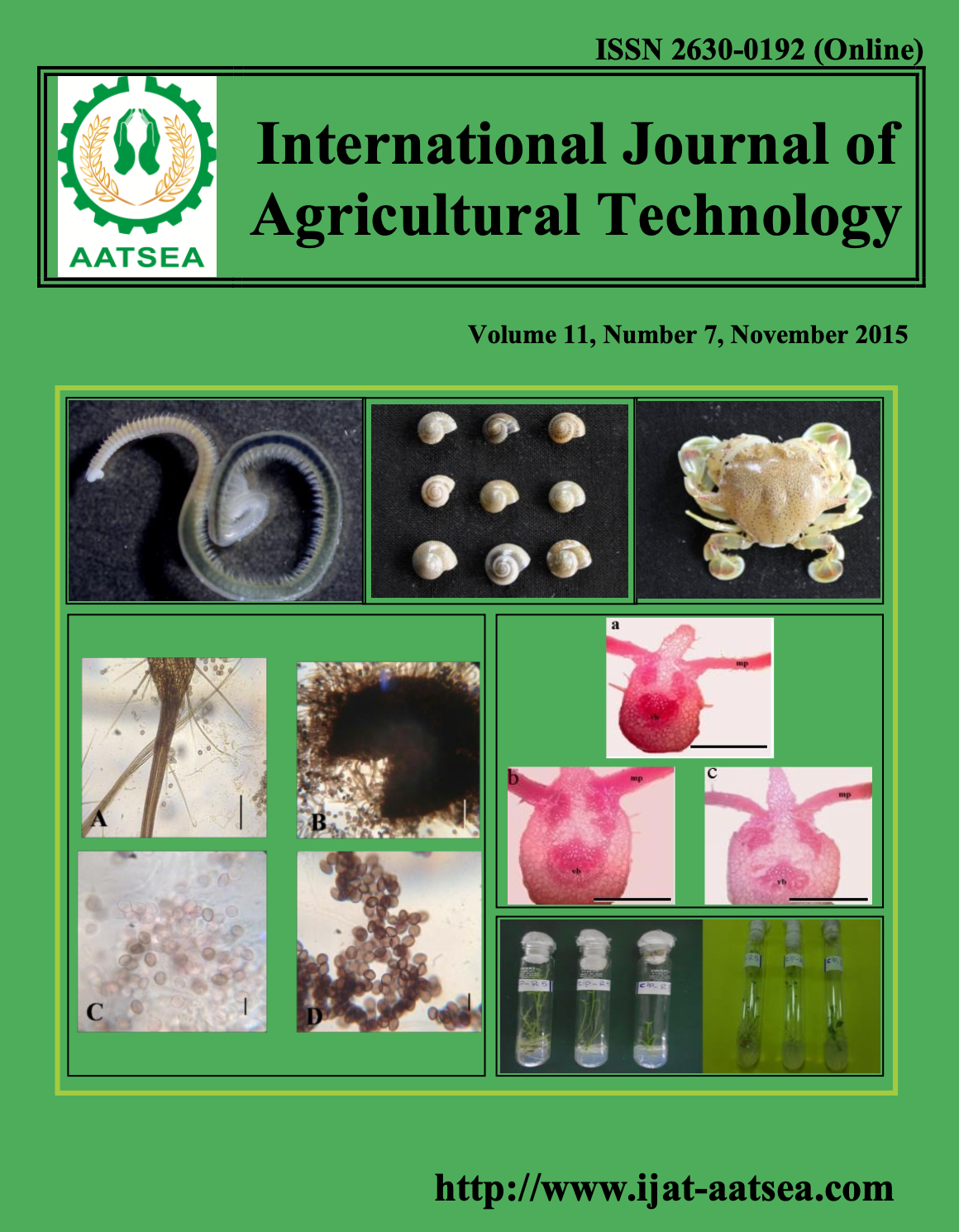The ecological characteristics of benthic macrofauna and the application of marine biotic index (ambi) to assess tourism beaches health in Krabi Province, Thailand
Main Article Content
Abstract
Article Details

This work is licensed under a Creative Commons Attribution-NonCommercial-NoDerivatives 4.0 International License.
References
Allen, C. J. (2010). Ecology of the intertidal crab Dotilla intermedia from tsunami impacted beaches in Thailand. (Doctor of Philosophy’s Thesis). University of Southampton, UK.
APHA (2005). Standard Methods for the Examination of Water and Wastewater. 21st ed. Washington, DC, USA.
Borja, A., Franco, J. and Perez, V. (2000). A marine biotic index to establish the ecological quality of soft-bottom benthos within European estuarine and coastal environments. Marine Pollution Bulletin 40:1100-1114.
Borja, A., Mader, J. and Muxika, I. (2012). Instructions for the use of the AMBI index software (Version 5.0), Revista de Investigacion Marina, AZTI-Tecnalia 19:71-82.
Dauvin, J., Bellan, G. and Bellan-Santini, D. (2010). Benthic indicators: From subjectivity to objectivity- Where is the line?. Marine Pollution Bulletin 60:947-953.
Defeo, O., McLanchlan, A., Schoeman, D. S., Schlacher, T. A., Dugan, J., Jones, A., Lastra, M. and Scapini, F. (2009). Threats to sandy beach ecosystems: A review. Estuarine, Coastal and Shelf Science 81:1-2.
De Pas, L., Neto, J. M., Marques, J. C. and Laborda, A. J. (2008). Response of intertidal macrobenthic communities to long term human induced changes in the EO estuary (Asturias, Spain): Implication for environmental management. Marine Environmental Research 66:288-299.
Eleftheriou, A., and McIntyre, A. (2005). Methods for the study of marine benthos, 3rd ed. Blackwell, Oxford, UK: John Wiley & Sons.
Ellis, D. V. (2005). Biodiversity reduction on contaminated sediments in the sea: Contamination or sediment mobility? Marine Pollution Bulletin 50:244-246.
Environmental Monitoring and Support Laboratory Office of Research and Development. (1986). Manual for identification of marine invertebrates: A guide to some common estuarine macroinvertebrates of the big bend region, Tampa bay, Florida. United States Environmental Protection Agency, Ohio, USA.
Fauchald, K. (1977). The polychaete worms: Definitions and keys to the orders, families and genera, Science Series vol. 28. Natural History Museum of Los Angeles County, Los Angeles, USA.
Gray, J. S., Clarke, K. R., Warwick, R. M. and Hobbs, G. (1990). Detection of initial effects of pollutants on marine benthos: an example from Ekofisk and Eldfisk oilfields. Marine Ecology Progress Series 66:285-299.
Map of Thailand. (2010). Travel map of Thailand [On-line]. Available from http://www. map of thailand.org/.
Marine Environmental Laboratory (1995). Manual for the geochemical analyses of marine sediments and suspended particulate matter. United Nations Environmental Programme, Monaco.
Martinez-Crego, B., Alcoverro, T. and Romeo, J. (2010). Biotic indices for assessing the status of coastal waters: A review of strengths and weaknesses. Journal of Environmental Monitoring 12:1013-1028.
McLachlan, A. and Brown A. (2006). The ecology of sandy shores. 2nd ed., London: Academic Press.
McLaughlin, P. A. (1998). A review of the hermit-crab (Decapoda: Anomura: Paguridea) fauna of southern Thailand, with particular emphasis on the Andaman Sea, and descriptions of three new species. Proceedings of the International Workshop on the Crustacea of the Andaman Sea, Phuket. pp. 385-460.
Nootmorn, P., Chayakun, R. and Chullasorn, S. (2003). The Andaman ecosystem in Thailand. Department of Fisheries, Bangkok.
Parravicini, V., Rovere, A., Vassallo, P., Micheli, F., Montefalcone, M., Morri, C., Paoli, C., Albertelli, G., Fabiano, M. and Bianchi, C. N. (2012). Understanding relationships between conflicting human uses and coastal ecosystems status: a geospatial modeling approach. Ecological Indicator 19:253-263.
Pollution Control Department (2007). Thailand Marine Water Quality Standard. Pollution Control Department, Ministry of Natural Resources and Environment, Bangkok.
Poutiers, J. M. (1998). The living marine resources of the Western Central Pacific. Volume I Seaweeds, corals, bivalves and gastropods. In: FAO species identification guide for fisheries purposes (Eds Carpenter KE, Niem VH). Italy: Food and Agriculture Organization of the United Nations. pp. 1-686.
Svanberg, O. (1996). Monitoring of biological effects. Resources, Conservation and Recycling 16:351-360.
Swennen, C., Moolenbeek, R. G., Ruttanadakul, N., Hobbelink, H., Dekker, H. and Hajisamae, S. (2001). The molluscs of the Southern Gulf of Thailand. Bangkok: The Biodiversity Research and Training Program.
Teixeira, H., Borja, A., Weisberg, S. B., Ranasinghe, J. A., Cadien, D. B., Dauer, D. M., Dauvin, J., Degraer, S., Dias, R. J., Gremare, M., Karakassis, I., Lianso, R. J., Lovell, L. L., Marques, J. C., Montagene, D. E., Occhipinti-Ambrogi, A., Rosenberg, R., Sarda, R., Schaffner, L. C. and Velarde, R. G. (2010). Assessing coastal benthic macrofauna community condition using best professional judgment-developing consensus across North America and Europe. Marine Pollution Bulletin 60:589-600.
Weisberg, S. B., Ranasinghe, J. A., Schaffner, L. C., Diaz, R. J., Dauer, D. M. and Frithsen, J. B. (1997). An estuarine benthic index of biotic integrity (B-IBI) for Chesepeake Bay. Estuaries 12:149-158.


